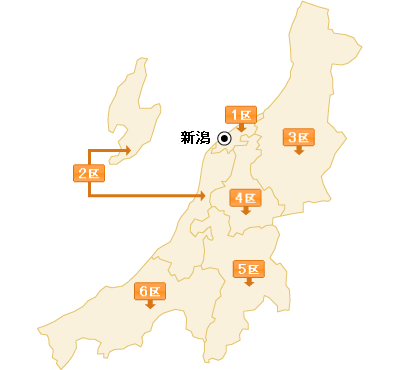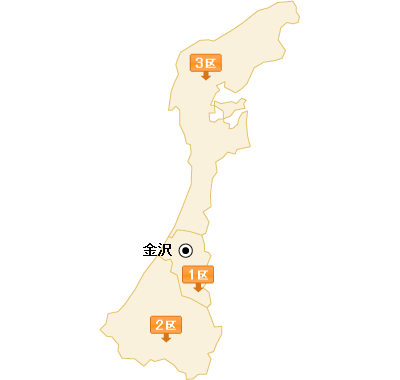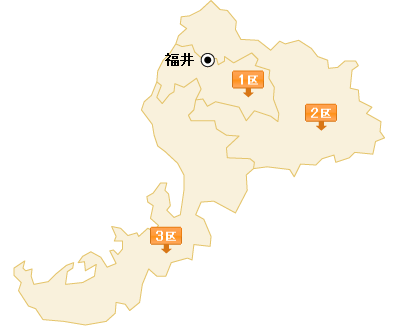This is the sixth installment in my general election guide. For an explanation of my purpose in making this guide, see here. For previous installments, see here, here, here, here, and here.
The Hokuriku-Shinetsu region, comprised of Niigata, Toyama, Ishikawa, Fukui, and Nagano prefectures, has twenty single-member districts and eleven proportional representation seats.
The Hokuriku-Shinetsu region, comprised of Niigata, Toyama, Ishikawa, Fukui, and Nagano prefectures, has twenty single-member districts and eleven proportional representation seats.
In 2005, opposition parties took seven SMDs and five proportional representation seats; the LDP and Komeito combined for thirteen SMDs and six PR seats, results that were identical to the 2003 election. This result suggests that the region was largely immune to the 2005 Koizumi boom, whle being relatively skeptical about the DPJ. Will it be more susceptible to a DPJ boom this year?
Niigata
Niigata has six SMDs, giving it the most seats in the block's prefectures. The DPJ has done better than the LDP in Niigata in the past two elections, winning three seats to the LDP's two.
 Its three incumbents — Nishimura Chinami, who is facing Yoshida Rokuzaemon, the LDP incumbent she defeated to first win the seat in 2003, in the first district; Kikuta Makiko, who for the second time will face Kurihara Yoji, the son of the LDP member she defeated to win the fourth district in 2003; and Tsutsui Nobutaka, who will face the LDP's Takatori Shuichi for the third time — ought to be safe. The DPJ has gained another incumbent in Tanaka Makiko, who won the fifth district as an independent in 2003 and 2005 and should be reelected easily this year. Tanaka had already been allied with the DPJ and had already received the party's endorsement, so her joining the party is a formality as far as her status as a candidate is concerned. (The DPJ also recovers a much-needed seat in the upper house as Tanaka's husband Naoki will also be joining the DPJ.)
Its three incumbents — Nishimura Chinami, who is facing Yoshida Rokuzaemon, the LDP incumbent she defeated to first win the seat in 2003, in the first district; Kikuta Makiko, who for the second time will face Kurihara Yoji, the son of the LDP member she defeated to win the fourth district in 2003; and Tsutsui Nobutaka, who will face the LDP's Takatori Shuichi for the third time — ought to be safe. The DPJ has gained another incumbent in Tanaka Makiko, who won the fifth district as an independent in 2003 and 2005 and should be reelected easily this year. Tanaka had already been allied with the DPJ and had already received the party's endorsement, so her joining the party is a formality as far as her status as a candidate is concerned. (The DPJ also recovers a much-needed seat in the upper house as Tanaka's husband Naoki will also be joining the DPJ.)In the remaining two seats, the LDP is vulnerable. The DPJ stands a good chance of winning in the second district, where DPJ candidate Washio Eiichiro, who lost by 12,000 votes and came away with a PR seat in 2005, once again faces LDP candidate Kondo Motohiko. The question, however, is whether the SDPJ, fielding candidate Yoneyama Noboru, will play the spoiler in the race. But Washio should benefit from the tailwind in the DPJ's favor, and it is unclear whether the SDPJ enjoys much support in the district (based on local election results).
The DPJ will have a harder time in the third district, where Inaba Yamato, a five-term incumbent, will face DPJ candidate Kuroiwa Takahiro. Kuroiwa is a strong challenger, a former upper house member from Niigata who lost in 2007 precisely as a result of infighting between the DPJ and the SDPJ in Niigata. Inaba won by approximately 38,000 votes in the past two elections, but against an experienced challenger like Kuroiwa he may be vulnerable. Kuroiwa should benefit from having the field to himself, no JCP candidate, no SDPJ candidate. In 2005, with SDPJ, PNP, and JCP candidates in the district, the three opposition candidates roughly equaled Inaba.
The DPJ could win all six districts in Niigata.
Toyama
In Toyama in 2003, the LDP took two seats and the PNP's Watanuki Tamisuke won the third district by 20,000 votes despite sharing the field with candidates from the LDP, DPJ, SDPJ, and JCP. Watanuki will not be running in the district this year, and will instead be running solely as a PR candidate. With the non-LDP slot open, the DPJ, the SDPJ, and the PNP will be backing
 independent Aimoto Yoshihiko, a longtime announcer at Kitanihon Broadcasting, against the LDP's Tachibana Keiichiro, former mayor of Takaoka city. Aimoto should win due to wider name recognition and the national mood. Your Party is running a candidate in this district — former Toyama assemblyman Shibata Takumi — but it remains to be seen whether YP will be a factor in this or any race.
independent Aimoto Yoshihiko, a longtime announcer at Kitanihon Broadcasting, against the LDP's Tachibana Keiichiro, former mayor of Takaoka city. Aimoto should win due to wider name recognition and the national mood. Your Party is running a candidate in this district — former Toyama assemblyman Shibata Takumi — but it remains to be seen whether YP will be a factor in this or any race.The LDP should win the second district easily: incumbent Miyakoshi Mitsuhiro has won comfortably over fields divided among DPJ, SDPJ, and JCP candidates in the past two elections, but even with the opposition uniting behind the SDPJ's Fujii Soichi, opposition candidates combined in recent elections have barely surpassed 50,000 votes, compared with Miyakosho's totals in the 90,000s.
The LDP could, however, be upset in the first district, where incumbent Nagase Jinen faces the DPJ's Murai Muneaki. Murai ran in both 2003 and 2005, and won PR seats both times. In 2005 Murai narrowed Nagase's margin of victory from 25,000 to just under 19,000 votes, suggesting that Murai might be able to unseat six-time incumbent Nagase. The JCP, which has received roughly 10,000 votes in previous elections, could be a factor in a close race.
The DPJ could win two of Toyama's three seats.
Ishikawa
Ishikawa also has three SMDs. The LDP won all three in 2005, and two of three in 2003.
 The DPJ will likely retake the first district, which it lost in 2005: Okuda Ken, the loser in 2005, narrowly defeated the LDP's Hase Hiroshi to win the seat in 2003, after narrowly losing to Hase in 2000. Okuda first won the seat in a 1998 by-election following his father's death. He should benefit from this year's DPJ boom.
The DPJ will likely retake the first district, which it lost in 2005: Okuda Ken, the loser in 2005, narrowly defeated the LDP's Hase Hiroshi to win the seat in 2003, after narrowly losing to Hase in 2000. Okuda first won the seat in a 1998 by-election following his father's death. He should benefit from this year's DPJ boom.The DPJ candidates in the second and third are weaker, however, and the LDP incumbents stronger: former Prime Minister Mori Yoshiro is the incumbent in the second district, and in the third district LDP incumbent Kitamura Shigeo, who first won the seat in 2005, defends a seat that had previously been held by longtime LDP politician Kawara Tsutomu.
Fukui
The LDP also won all three seats in Fukui in 2005 and 2003.
 In this election, however, the DPJ could win two out of three seats. The LDP's incumbent in the second district, Yamamoto Taku, is probably safe, but in the first district the LDP's Inada Tomomi, elected for the first time in 2005 thanks to a non-LDP vote divided between the DPJ's Sasaki Ryuzo and the former LDP candidate Matsumiya Isao. Despite the divided vote, Sasaki still lost by only 400 votes. This time Matsumiya will be running in the third district as a DPJ candidate against the LDP's Takagi Tsuyoshi, who has won the past three elections handily. Both Sasaki and Matsumiya may win this time around.
In this election, however, the DPJ could win two out of three seats. The LDP's incumbent in the second district, Yamamoto Taku, is probably safe, but in the first district the LDP's Inada Tomomi, elected for the first time in 2005 thanks to a non-LDP vote divided between the DPJ's Sasaki Ryuzo and the former LDP candidate Matsumiya Isao. Despite the divided vote, Sasaki still lost by only 400 votes. This time Matsumiya will be running in the third district as a DPJ candidate against the LDP's Takagi Tsuyoshi, who has won the past three elections handily. Both Sasaki and Matsumiya may win this time around.Nagano
In the past two elections the LDP has won three seats in Nagano and the DPJ two.
 DPJ incumbents Hata Tsutomu (third district) and Shimojo Mitsu (second district) should win comfortably. The DPJ's best chance for picking up a seat is in the first district, where its candidate Shinohara Takashi will try for the third time to unseat LDP incumbent Kosaka Kenji. Shinohara has won PR seats in the past two elections, losing by 7,000 votes in 2003 and 19,000 votes in 2005. The JCP, whose candidates have received more than 30,000 votes in the past two elections, could make a difference in a close race in the first, but with the national mood it may not be that close.
DPJ incumbents Hata Tsutomu (third district) and Shimojo Mitsu (second district) should win comfortably. The DPJ's best chance for picking up a seat is in the first district, where its candidate Shinohara Takashi will try for the third time to unseat LDP incumbent Kosaka Kenji. Shinohara has won PR seats in the past two elections, losing by 7,000 votes in 2003 and 19,000 votes in 2005. The JCP, whose candidates have received more than 30,000 votes in the past two elections, could make a difference in a close race in the first, but with the national mood it may not be that close.In the final two districts, the LDP will likely hold in the fifth district, where its incumbent, Miyashita Ichiro, has never faced a serious challenge. He will be helped this time because both the DPJ and the SDPJ will both be running candidates, in addition to a JCP candidate. In the fourth district, the LDP incumbent Goto Shigeyuki could have been defeated in 2003 but both the DPJ and the SDPJ fielded candidates, clearing the way for Goto's reelection. This time the DPJ's Yazaki Koji, a former Mainichi journalist, will share the field with only the JCP's Ueda Hideaki.
The DPJ could win four of five districts in Nagano.
Proportional representation
Using the d'Hondt method simulator, Yomiuri's poll numbers, and turnout data from 2005, it appears that should the DPJ receive in Hokuriku Shinetsu what it is polling nationally it can win six seats, which, combined with the one seat the PNP should win in the block would yield seven for the DPJ and its likely coalition, while limiting the LDP to four and stripping Komeito of its seat.
All told, the DPJ could win twenty seats in the block, with its partner the PNP winning one and an opposition-backed independent's winning one, exceeding the LDP-Komeito coalition's nineteen seats from 2005. The LDP, meanwhile, could be limited to nine seats in the block.

No comments:
Post a Comment